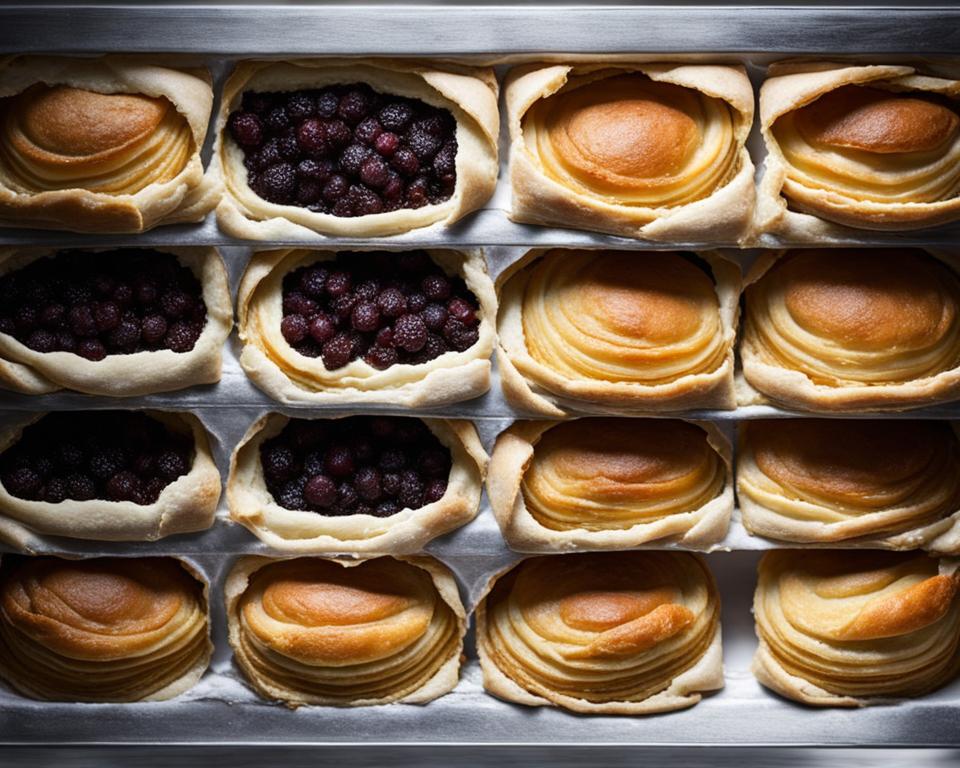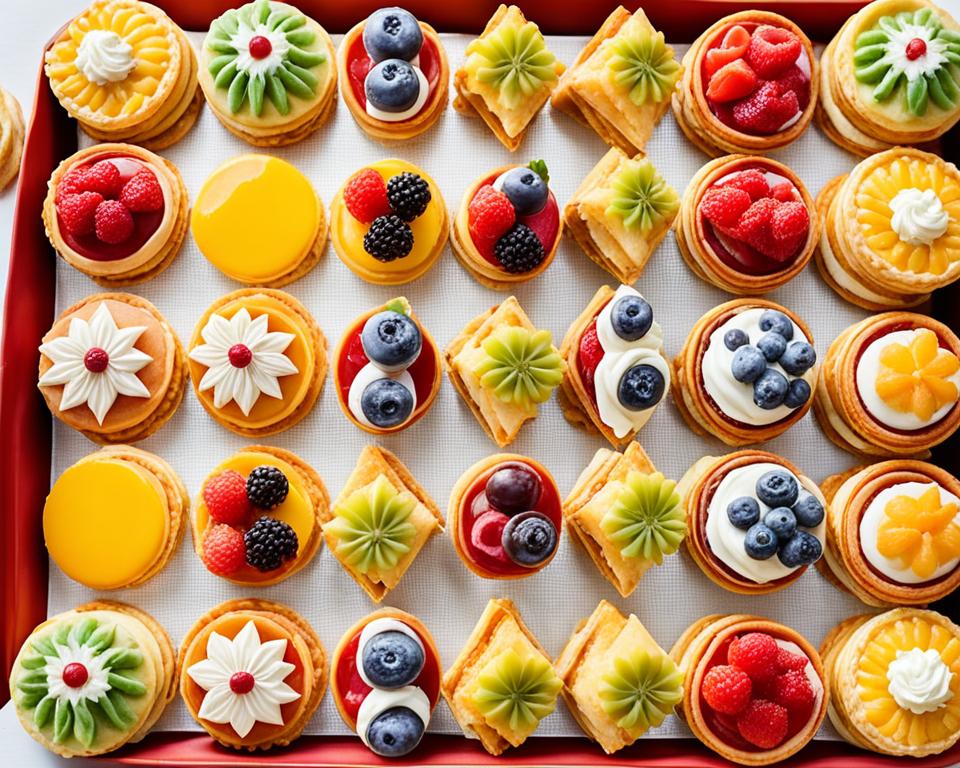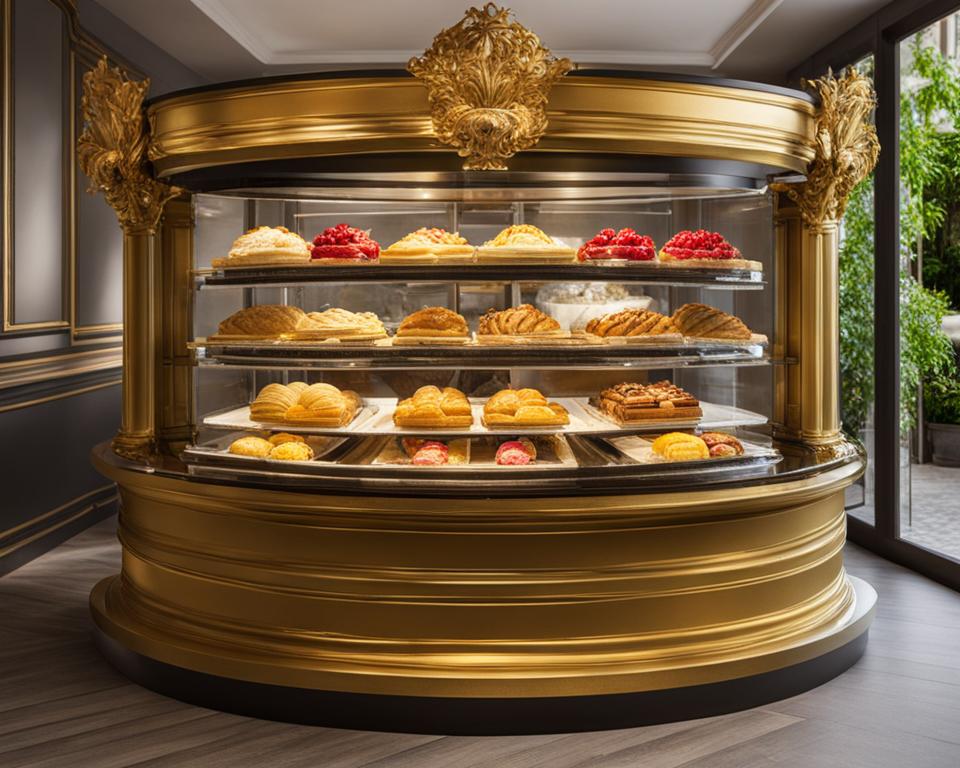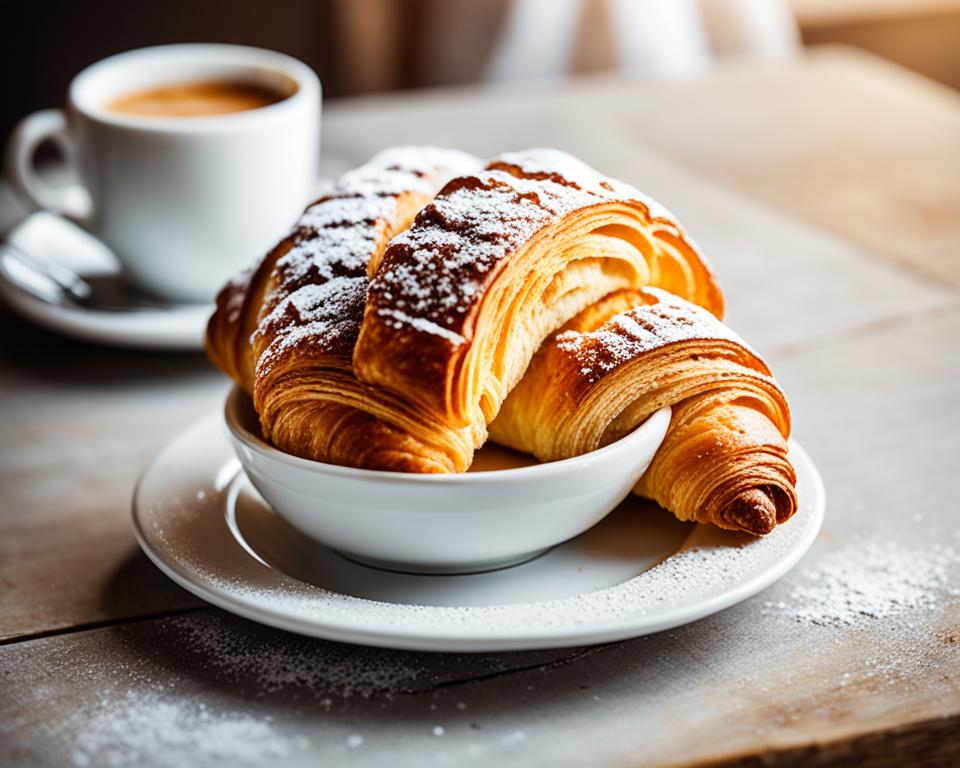When it comes to baked goods, achieving a flaky texture is key. Whether it’s a pie crust, a turnover, or a pastry, that delicate, crisp, and multi-layered quality is what takes a baked treat from ordinary to extraordinary. But what exactly does it mean for something to be “flaky” in baking?
Flaky refers to the texture of baked goods that are created using a special technique called lamination. This involves layering fat, usually butter or shortening, between layers of dough. When the pastry bakes, the fat melts and creates steam, which then lifts the layers and creates that desirable flakiness.
Flaky pastries have fewer layers and less fat than puff pastry, but they still offer that irresistible texture and taste. They are commonly used for pie crusts, turnovers, and other delicious treats. To achieve the perfect flaky pastry, it’s important to master the technique and follow specific steps.
Key Takeaways:
- Flaky refers to the delicate, crisp, and multi-layered texture of baked goods.
- Flaky pastries are made using the lamination technique, which involves layering fat between layers of dough.
- Flaky pastries have fewer layers and less fat than puff pastry but still offer a delightful texture and taste.
- Mastering the technique and following specific steps are important for achieving the perfect flaky pastry.
- Flaky pastries are commonly used for pie crusts, turnovers, and other delicious treats.
Understanding Flaky Pastry
Flaky pastry is a delightful addition to any baker’s arsenal, offering a crisp and delicate texture that elevates baked goods to new heights. To truly understand the art of flaky pastry, we must delve into its unique characteristics and compare it to traditional puff pastry.
Unlike puff pastry, which consists of a single block of butter sandwiched between layers of dough, flaky pastry incorporates small chunks of fat throughout the dough. This results in discontinuous layers of fat that create the signature flaky texture when baked. The distribution of fat in flaky pastry is distinct from the uniform distribution in puff pastry.
But why does this difference matter? The distinct fat distribution in flaky pastry allows for a faster and easier preparation process compared to the time-consuming method used for puff pastry. Flaky pastry can be made by cutting the fat into the dough, whereas traditional puff pastry requires multiple rounds of rolling and folding to create the desired layers.
Let’s take a closer look at the process of making flaky pastry. By incorporating small chunks of fat into the dough, we create pockets of fat that melt during baking, resulting in the airy and crispy texture. This lamination process involves folding the dough several times to create multiple layers. The technique used for flaky pastry is simpler and more accessible for home bakers, allowing them to achieve professional-level results without the lengthy preparation required for puff pastry.
It’s important to note that the choice between flaky pastry and puff pastry depends on the desired outcome and application. Flaky pastry excels in creating pie crusts, turnovers, and other baked goods that benefit from a lighter, less voluminous texture. On the other hand, puff pastry is ideal for delicate pastries such as vol-au-vents, where a higher volume and delicate, buttery layers are desired.
Ultimately, understanding flaky pastry and the nuances that differentiate it from puff pastry empowers us to explore new possibilities in our baking endeavors. With the right techniques and a creative mindset, we can create delectable treats that showcase the irresistible flaky texture.
Now that we have gained a deeper appreciation for flaky pastry, let’s move on to Section 3: Flaky Pastry Recipe, where we will discover the secrets to making high-quality flaky pastry and explore valuable tips for success.
Flaky Pastry Recipe
Creating a high-quality flaky pastry requires proper incorporation of fat into the dough and careful lamination. Follow these tips to achieve the perfect flaky texture in your pastries:
- Mix the dry ingredients: Start by combining the flour and salt in a mixing bowl. Cut in a portion of cold, cubed fat, such as butter or shortening. Use your fingers or a pastry cutter to work the fat into the flour until the mixture resembles coarse crumbs.
- Rest the dough: Wrap the dough in plastic wrap and let it rest in the refrigerator for at least 30 minutes. This allows the gluten in the flour to relax and the fat to solidify, resulting in a flakier texture.
- Sheet the dough: Roll out the rested dough on a lightly floured surface to the desired thickness. Be gentle while rolling to avoid melting the fat and maintaining a consistent thickness.
- Laminate the dough: Fold the sheeted dough into thirds, like a letter. Rotate the dough 90 degrees and roll it out again. Repeat this folding and rolling process at least three times to create layers of fat and dough.
- Maintain low temperatures: Throughout the entire process, it is important to keep the dough and fat as cool as possible. This helps prevent the fat from melting too quickly and ensures the desired flaky texture.
With these steps, you can create a buttery and flaky pastry that will impress your family and friends. Now, let’s take a look at the resulting texture of a high-quality flaky pastry:
| Texture | Description |
|---|---|
| The high-quality flaky pastry has a golden-brown color with visible layers that are light, airy, and crisp. Each bite offers a delicate crunch and a melt-in-your-mouth sensation. |
Tips for preparing flaky pastry:
“To achieve the best results, ensure that the fat is evenly distributed throughout the dough and take care to maintain a low temperature during the preparation process.” – Baking Tips
Now that you have the recipe and tips, it’s time to get baking and enjoy the irresistible flaky texture of your homemade pastries.
Factors Affecting Flaky Pastry Texture
When it comes to achieving the perfect flaky pastry, several factors come into play. Understanding these factors and how they affect the final texture is key to creating delicious baked goods. Let’s take a closer look at the important elements that can make or break your flaky pastry.
Dough Development
The development of the dough is crucial in creating that coveted flaky texture. Both overmixing and undermixing can lead to issues. Overmixing can result in a tough pastry, while undermixing may leave you with an uneven texture. It’s important to find the right balance and mix the dough just until the ingredients come together.
Gluten Development
Another important factor is gluten development. Gluten is formed when water mixes with proteins in the flour. Proper gluten development gives the dough strength and elasticity, allowing it to withstand the folding and lamination process. However, excessive gluten development can result in a chewy texture rather than the desired flakiness.
Temperature Control
Temperature control is crucial throughout the entire production process. It’s important to keep the dough and fat at the right temperature to achieve the desired results. If the fat becomes too warm, it may melt and disrupt the layering process, resulting in a less flaky texture. On the other hand, if the fat becomes too cold, it may not distribute evenly, leading to inconsistent layers.
“Proper dough and gluten development, along with careful temperature control, are essential for achieving the perfect flaky texture in your pastries.”
Commercial-Scale Production
In commercial-scale production, additional attention needs to be paid to gluten development. When using reduction rollers, which are commonly used in large-scale pastry production, achieving proper gluten development becomes more challenging. The reduction roller process puts extra stress on the dough, making it even more important to ensure the gluten is properly developed during mixing.
| Factors Affecting Flaky Pastry Texture | Impact |
|---|---|
| Dough Development | Determines the texture and consistency of the pastry |
| Gluten Development | Affects the dough’s ability to withstand folding and lamination |
| Temperature Control | Ensures proper fat distribution and prevents issues with layering |
| Commercial-Scale Production | Presents challenges in achieving proper gluten development |
Understanding these factors and how they interplay is key to achieving the flaky pastry texture you desire. By paying attention to dough development, gluten development, and temperature control, you can create pastries that are light, flaky, and irresistibly delicious.
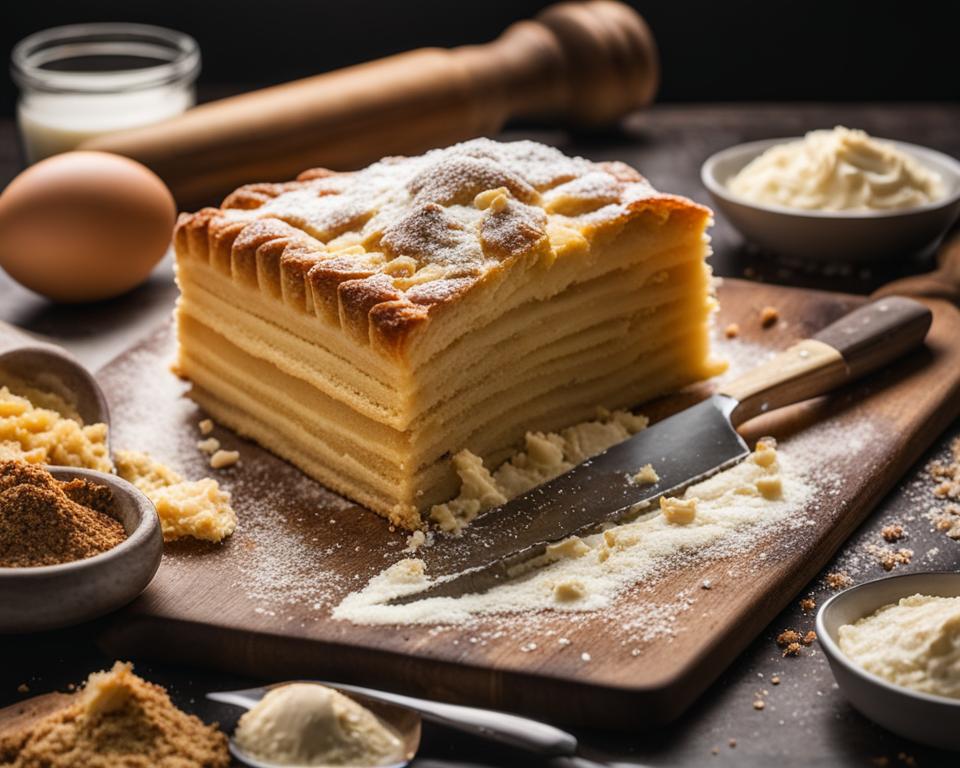
Varying Flaky Pastry Textures
Flaky pastry is known for its delightful texture that adds a unique experience to baked goods. But did you know that the texture of flaky pastry can vary depending on different factors? Let’s explore how changing fat content and distribution, as well as using different types of flour, can affect the texture and taste of flaky pastry.
Changing Fat Content and Distribution
The amount and type of fat used in flaky pastry can significantly impact its texture. By adjusting the fat content, you can create pastries that range from light and delicate to rich and buttery. Similarly, changing the distribution of fat within the dough can result in different layers and levels of flakiness.
If you prefer a lighter texture, you can reduce the fat content while still maintaining the distinct flaky layers. On the other hand, increasing the fat content will yield a more indulgent pastry with a richer mouthfeel. Experimenting with different fat ratios allows you to find the perfect balance that suits your desired flaky pastry texture.
Different Types of Flour
The choice of flour also plays a role in the texture of flaky pastries. Different types of flour, such as all-purpose flour, bread flour, or pastry flour, have varying protein contents and gluten-forming properties. These factors affect the structure and crumb of the pastry.
All-purpose flour, with its moderate protein content, is a popular choice for flaky pastry, as it provides a good balance between tenderness and structure. However, if you prefer a more tender and delicate texture, using pastry flour, which has a lower protein content, can achieve that desired result.
Conversely, if you’re looking for a sturdier and more substantial flaky pastry, bread flour, with its higher protein content, can lend more structure and chewiness. Experimenting with different flours allows you to tailor the texture of your flaky pastry to suit your specific baking needs.
“The amount and type of fat used, as well as the choice of flour, are key factors in achieving the perfect flaky pastry texture.”
As you can see, the texture of flaky pastry is not set in stone. By varying the fat content and distribution, as well as using different types of flour, you have the power to create a wide range of textures, from light and airy to rich and decadent. Whether you prefer a delicate puff or a robust rough puff, the versatility of flaky pastry allows you to explore different flavors and experiences.
Tips for Achieving the Perfect Flaky Texture
When it comes to creating flaky pastries that are light and delicate, following best practices is essential. Achieving the perfect flaky texture requires attention to detail and careful execution. Here are some tips to help you master the art of creating irresistibly flaky pastries:
- Properly incorporate the fat: The fat in your pastry dough plays a crucial role in creating the desired flaky texture. Ensure that you evenly distribute and incorporate the fat into the dough during the initial mixing process. This will help create distinct layers when the pastry bakes.
- Maintain low temperatures: Throughout the preparation process, it is important to work with cold ingredients and keep your dough at a low temperature. This helps prevent the fat from melting prematurely and allows the layers to form properly during lamination.
- Rotate the dough during lamination: As you fold and roll out your pastry dough, make sure to rotate it during each lamination step. This helps distribute the fat evenly and reduces stress on the dough, resulting in a more uniform and flaky texture.
- Allow the dough to rest: Between each successive fold and lamination, it is crucial to allow the dough to rest. This resting period allows the gluten in the dough to relax and the fat to firm up, making it easier to work with and ensuring proper lamination.
By following these tips and best practices, you’ll be well on your way to achieving the perfect flaky texture in your pastries. With practice and a little patience, you can create pastries that are light, crisp, and irresistibly flaky.
| Tip | Description |
|---|---|
| Properly incorporate the fat | Evenly distribute the fat into the dough to create distinct layers. |
| Maintain low temperatures | Work with cold ingredients and keep the dough at a low temperature to prevent premature fat melting. |
| Rotate the dough during lamination | Rotate the dough during each lamination step to distribute the fat evenly and reduce stress on the dough. |
| Allow the dough to rest | Rest the dough between folds to relax the gluten and allow the fat to firm up, ensuring proper lamination. |
Flaky Pastry vs. Puff Pastry
When it comes to pastry, flaky and puff pastry are two popular options with their own unique characteristics. Understanding the differences between the two can help you choose the right pastry for your baking needs.
The Differences
Flaky pastry and puff pastry differ in terms of fat content, number of layers, and application. Flaky pastry has a lower fat content and fewer layers compared to puff pastry. This makes it more suitable for pie crusts, turnovers, and other baked goods that require a sturdy, yet flaky texture.
Puff pastry, on the other hand, is designed for applications that require a higher volume and delicate texture, such as vol-au-vents or bouchees. It contains a higher fat content and is made by encasing a block of butter between layers of dough. During baking, the butter creates steam, resulting in the signature “puff” and light, airy texture.
Applications of Flaky Pastry
Flaky pastry has a wide range of applications in various baked goods. Its crisp and flaky texture adds a delightful crunch and enhances the taste and appearance of pies, turnovers, sausage rolls, and plaits. The versatility of flaky pastry makes it a favorite among both professional bakers and home cooks.
Here are some popular applications of flaky pastry:
- Pie crusts
- Turnovers
- Sausage rolls
- Plaits
With its lighter texture and ease of preparation, flaky pastry is a fantastic choice for creating delicious and visually appealing baked goods.
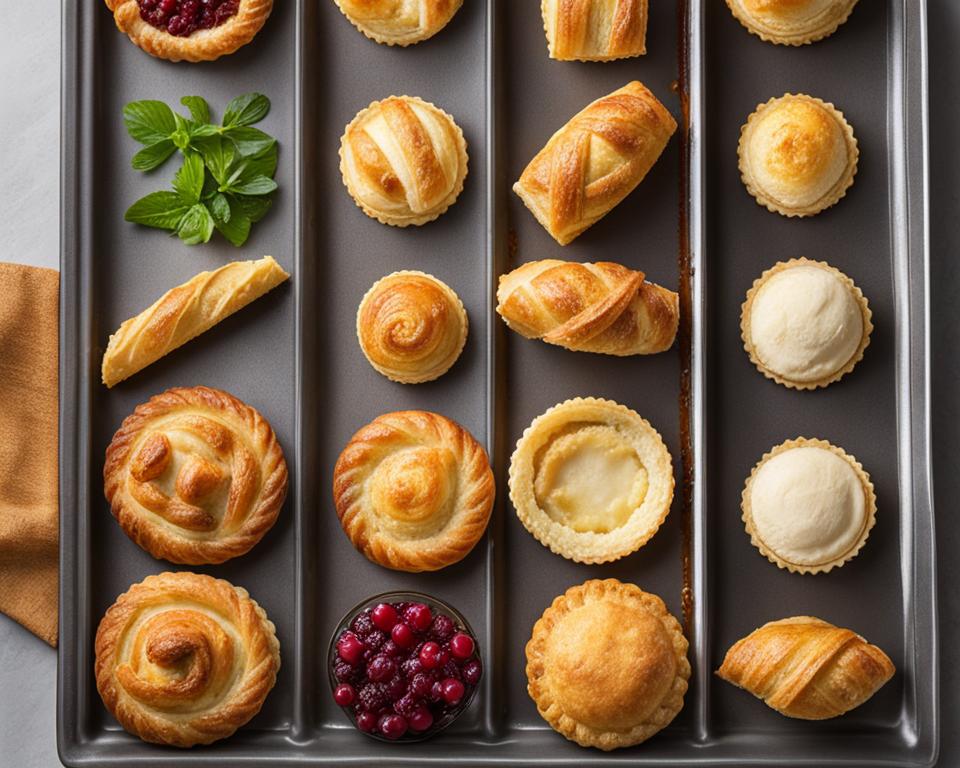
| Features | Flaky Pastry | Puff Pastry |
|---|---|---|
| Fat Content | Lower | Higher |
| Number of Layers | Fewer | More |
| Application | Pie crusts, turnovers, sausage rolls, plaits | Vol-au-vents, bouchees, laminated pastries |
Table: A comparison of flaky pastry and puff pastry.
While flaky pastry and puff pastry share some similarities in the lamination process, their distinct characteristics make them suitable for different applications. So whether you’re making a flaky pie crust or a buttery vol-au-vent, choosing the right pastry dough is essential for achieving the desired texture and flavor.
Flaky Pastry in Different Baked Goods
Flaky pastry is a versatile ingredient that can be used in various baked goods, adding a delightful crunch and enhancing the taste and appearance of pastries. Whether you’re a professional baker or a home cook, flaky pastry offers endless possibilities to create delicious treats. Let’s explore some popular applications of flaky pastry in baking:
Pie Crusts
Flaky pastry is commonly used to make pie crusts, providing a delicate and buttery texture that perfectly complements sweet or savory fillings. The crisp layers of flaky pastry create a beautiful contrast to the rich and juicy fillings, making every bite a heavenly experience.
Turnovers
Pastries made with flaky pastry, such as turnovers, are a delightful treat that can be enjoyed any time of day. The light and airy texture of the flaky layers creates a satisfying mouthfeel, while the fillings burst with flavor. Whether filled with fruit, vegetables, or meat, turnovers made with flaky pastry are a delicious on-the-go snack or a scrumptious addition to a brunch spread.
Sausage Rolls
Sausage rolls are a classic crowd-pleaser, and flaky pastry is the key to their irresistible texture. The layers of flaky pastry enveloping the savory sausage filling create a perfect balance of crispness and tenderness. These savory treats are a hit at parties, picnics, and anytime you’re craving a delicious handheld bite.
Plaits
Flaky pastry can also be shaped into beautiful plaits, adding an elegant touch to any pastry creation. Whether filled with sweet or savory ingredients, plaits made with flaky pastry are not only visually appealing but also offer a delectable texture with each flaky layer.
With its simplicity and ease of working, flaky pastry is a popular choice for both professional bakers and home cooks. Its versatility allows for a wide range of baked goods that are sure to impress. So, let’s get baking with flaky pastry and create irresistible treats that will delight everyone.
Flaky Pastry Around the World
Flaky pastry is not limited to a specific cuisine but is enjoyed worldwide. Each culture has its own unique way of using flaky pastry in traditional recipes and pastries. It is known by different names in various countries, such as quick pastry, blitz pastry, or rough puff. From Chinese flaky pastry to Turkish börek, the love for flaky textures in baking is truly universal.
Here are some examples of how flaky pastry is used in different parts of the world:
- China: In Chinese cuisine, flaky pastry is widely used in dishes such as char siu bao (barbecue pork buns) and egg tarts. The layers of flaky pastry provide a delicate texture that pairs well with savory or sweet fillings.
- Turkey: Turkish cuisine is famous for its börek, a savory pastry made with flaky layers of dough filled with various ingredients such as cheese, spinach, or minced meat. Börek is often served as a snack or appetizer.
- France: In France, flaky pastry is the base for classic desserts such as apple tarte tatin and mille-feuille. The light and airy texture of the pastry adds a luxurious touch to these indulgent treats.
- United States: Flaky pastry is commonly used in American pies, including apple pie and cherry pie. The buttery layers of pastry complement the sweet and juicy fillings, creating a perfect balance of flavors and textures.
As you can see, flaky pastry is a beloved culinary technique that transcends borders and is celebrated in various cuisines around the world. Its versatility and delicate texture make it a cherished component of both sweet and savory dishes.
Tips for Working with Flaky Pastry Dough
Working with flaky pastry dough requires some finesse. To achieve the perfect flaky texture, it’s important to handle the dough with care. Here are some tips to help you work with flaky pastry dough like a pro:
- Handle the dough gently: Flaky pastry dough is delicate, and excessive handling can cause the fat to melt and result in a tough texture. Treat the dough with care, gently rolling and shaping it.
- Roll out the dough evenly: When rolling out the dough, aim for an even thickness throughout. This ensures that the pastry bakes evenly and maintains a consistent flakiness. Use a rolling pin to gently roll the dough, starting from the center and working outwards.
- Maintain a consistent thickness: Pay attention to the thickness of the rolled-out dough. Flaky pastry requires a consistent thickness to ensure even baking. Use a ruler or measuring tape to check the thickness at different points, making adjustments if needed.
- Avoid overworking the dough: Overworking the dough can lead to tough pastry. Once the dough has been mixed and rolled, avoid excessive kneading or folding. The goal is to maintain the distinct layers of fat and dough that create the flaky texture.
- Be cautious of oven temperatures: Flaky pastry requires a hot oven to achieve the desired crispness. However, be mindful not to set the temperature too high, as this can cause the pastry to burn before it fully bakes. Follow the recipe’s recommended oven temperature and monitor the pastry closely while it bakes.
With practice and attention to detail, you can master the art of working with flaky pastry dough. Enjoy the process of creating deliciously flaky pastries that will impress your family and friends.
Flaky Pastry and Its Variations
Flaky pastry is a versatile dough that offers a wide range of textures and flavors. Alongside traditional flaky pastry, there are two popular variations: quick puff pastry and rough puff pastry. These variations provide unique characteristics and can be used in different applications to create delicious baked goods.
Quick Puff Pastry (Blitz Puff Pastry)
Quick puff pastry, also known as blitz puff pastry, falls between flaky pastry and traditional puff pastry in terms of fat content and ease of preparation. It incorporates a block of fat that is rolled and sheeted to create layers, resulting in a light and flaky texture.
This variation of flaky pastry is perfect for recipes that require a slightly richer and more delicate dough. It can be used to make elegant pastries such as vol-au-vents or savory tarts. The process of making quick puff pastry is quicker compared to traditional puff pastry, making it an ideal choice for those short on time.
Rough Puff Pastry
Rough puff pastry is another variation of flaky pastry that offers a distinct texture. It involves incorporating larger pieces of fat into the dough, resulting in a slightly rougher and more rustic texture.
While rough puff pastry requires more attention during lamination and folding, it offers a homemade appeal and can be used in recipes where a less refined texture is desired. It is perfect for making pies, turnovers, and savory tarts with a hearty and rustic feel.
These variations of flaky pastry provide bakers and pastry enthusiasts with creative possibilities and the ability to experiment with different textures and flavors. Whether you choose quick puff pastry or rough puff pastry, these variations will add an extra layer of depth and complexity to your baked goods.
Conclusion
Flaky pastry is a versatile and delicious addition to any baker’s repertoire. Its crisp and flaky texture adds depth and elegance to various baked goods. By following specific techniques and tips, you can achieve the perfect flaky pastry for your pies, turnovers, and more.
Whether you’re a professional baker or a home cook, experimenting with flaky pastry will elevate your baked goods to new heights. The process of incorporating fat into the dough and carefully laminating it through multiple folds creates a pastry that is light, delicate, and irresistibly flaky.
So get ready to indulge in the irresistible flaky textures that only flaky pastry can offer. With practice and attention to detail, you can master the art of creating flaky pastries that will impress your friends, family, and customers. Whether it’s a golden pie crust or a delectable turnover, flaky pastry will always be a crowd-pleaser.
FAQ
What is flaky in baking?
Flaky in baking refers to a desirable texture in pastries that is achieved by creating multiple layers of dough and fat through a lamination process. The resulting pastry is crisp and light, with a delicate flaky texture.
How is flaky pastry made?
Flaky pastry is made by cutting fat into the flour, followed by lamination through multiple folds. This process creates discontinuous fat layers that bake up into a crisp and flaky texture.
What is the difference between flaky and puff pastry?
Flaky pastry has a lower fat content and fewer layers than puff pastry, making it more suitable for pie crusts and turnovers. Puff pastry, on the other hand, has a higher fat content and more layers, resulting in a lighter, more delicate texture.
How can I achieve a perfect flaky texture in my pastries?
To achieve a perfect flaky texture, it is important to properly incorporate the fat into the dough, maintain low temperatures, and rotate the dough during lamination. Allowing the dough to rest between folds is also crucial for proper lamination.
What factors can affect the texture of flaky pastry?
Several factors can affect the texture of flaky pastry, including dough development, gluten development, and temperature control. Proper gluten development and maintaining low temperatures during the production process are essential for achieving the desired flaky texture.
How can I vary the texture of flaky pastry?
The texture of flaky pastry can be varied by changing the amount and type of fat used, as well as the method of lamination. Different types of flour can also affect the texture and taste of the final product.
What are the differences between flaky pastry and puff pastry?
Flaky pastry has a lower fat content and fewer layers than puff pastry, making it more suitable for certain applications such as pie crusts and turnovers. Puff pastry, on the other hand, has a higher fat content and more layers, resulting in a lighter and more delicate texture, making it ideal for applications like vol-au-vents or bouchees.
What can I make with flaky pastry?
Flaky pastry can be used in a variety of baked goods, including pie crusts, turnovers, sausage rolls, plaits, and more. Its flaky texture enhances the taste and appearance of these baked goods.
Is flaky pastry used in a specific cuisine?
Flaky pastry is enjoyed worldwide and is used in a variety of cuisines. It is known by different names in various countries and cultures, such as quick pastry, blitz pastry, or rough puff. Each culture has its own unique way of using flaky pastry in traditional recipes and pastries.
What tips can you give for working with flaky pastry dough?
When working with flaky pastry dough, it is important to handle the dough gently to prevent the fat from melting and creating a tough texture. Rolling out the dough evenly and maintaining a consistent thickness will ensure even baking and a flaky texture. Avoid overworking the dough and be cautious of oven temperatures to prevent a soggy pastry.
What are the variations of flaky pastry?
Some variations of flaky pastry include quick puff pastry (blitz puff pastry) and rough puff pastry. Quick puff pastry incorporates a block of fat rolled and sheeted into the dough, while rough puff pastry uses larger pieces of fat and results in a slightly rougher texture.
What is the appeal of flaky pastry in baking?
Flaky pastry is a versatile and delicious addition to any baker’s repertoire. Its crisp and flaky texture adds depth and elegance to various baked goods. By following specific techniques and tips, you can achieve the perfect flaky pastry for your pies, turnovers, and more.

